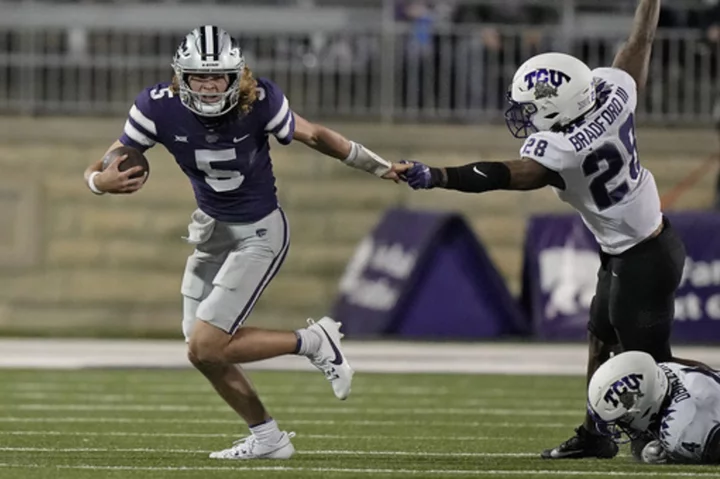HOYLAKE, England (AP) — A hole-by-hole look at Royal Liverpool, site of the 151st British Open that starts Thursday:
NO. 1, 459 YARDS, PAR 4: Two pot bunkers are to the right and two more are to the left. The right side of the fairway is preferred because it gives a better view of the green, which has bunkers left and right and a third one short and to the right.
NO. 2, 453 YARDS, PAR 4: The hole bends gently to the right, and players will need to avoid two bunkers on the right and one on left. Three bunkers protect the green, which slopes away on both sides. This is the 18th hole for members, but it was deemed too weak for a closing hole at the Open.
NO. 3, 426 YARDS, PAR 4: One of the more daunting tee shots at Royal Liverpool, with the prevailing wind out of the left, a dogleg to the right and out-of-bounds down the right side of the hole. Taking it over the dogleg is to risk going through the fairway. There are no bunkers, though the green is close to the out-of-bounds and features a swale on the left side of the green.
NO. 4, 367 YARDS, PAR 4: The shortest par 4 at Royal Liverpool requires a tee shot down the left side of a narrow fairway, staying short of two pot bunkers, to open up the second shot to a green built on the edge of the property. The green slopes to the back and it's guarded by four pot bunkers.
NO. 5, 520 YARDS, PAR 5: A good drive should set up a birdie opportunity, although the approach is into the prevailing wind. A dogleg that bends sharply to the left and is tightened by gorse bushes to the left and fairway bunkers on the right side. The green is heavily contoured and protected by bunkers in front right and front left.
NO. 6, 201 YARDS, PAR 3: The wind typically is into the player and from the right, so a long iron might be needed to a reach a long, narrow green that slopes from back to front and is guarded by bunkers on both sides. Particularly troublesome are the bunkers left of the green.
NO. 7, 481 YARDS, PAR 4: The landing area is protected by bunkers and deep rough on both sides. The aggressive play is down the right side to leave the best angle to the green, which is slightly hidden. A tee shot too far left means the approach likely has to contend with two bunkers guarding the front of the green.
NO. 8, 435 YARDS, PAR 4: This plays into the prevailing wind and requires a slightly blind tee shot over bushes to a landing area with gorse on the left and a bunker to the right. The second shot is straightforward to a large green protected by three bunkers.
NO. 9, 218 YARDS, PAR 3: The green is narrow and set beyond two bunkers on both sides of the entrance. The bunker on the right is designed to collect shots that are slightly off. The wind typically is from the left, and the green is surrounded by humps and hollows.
NO. 10, 507 YARDS, PAR 4: Out-of-bounds looms down the left side of the fairway, especially with the prevailing wind coming from the right off the Irish Sea. This played as a par 5 in 2006 and 2014 and now is only 25 yards shorter and plays as a par 4. Players must avoid the lone bunker at the front right of the green and a deep swale on the left. The putting surface falls away to the left. The hole is called “Far,” not so much for its length but because it’s the farthest point from the clubhouse.
NO. 11, 392 YARDS, PAR 4: This is the first of four holes that run along the shore of the Irish Sea. It is called “Punch Bowl” because the green is surrounded by dunes on all sides, with the putting surface angled sharply to the right. Two front bunkers are positioned to cut into more of the putting surface.
NO. 12, 449 YARDS, PAR 4: The sloping fairway tends to throw the ball to the right toward two bunkers as the hole turns left toward a raised green, which is surrounded by mounds and hollows. The green slopes sharply to the front. There are no bunkers around the green.
NO. 13, 194 YARDS, PAR 3: The green is set well back among the dunes and is oblong in shape, so club selection will be critical to get the tee shot within birdie range, and the sand hills block the left side of the green. A lone bunker protects the front right side. A swale separates the back of the green and dune beyond it.
NO. 14, 454 YARDS, PAR 4: One of the toughest driving holes, this sharp dogleg to the left has bunkers on the inside of the dogleg and to the right side of the fairway. The green drops away into a hollow on the right, and two bunkers are positioned some 30 yards to the left of the green. The approach has to be hit over the side of a hill to the narrow green. Tiger Woods holed out for eagle in the second round in 2006 with a 4-iron.
NO. 15, 620 YARDS, PAR 5: This was the 16th hole for the previous two Opens, except now it is some 45 yards longer. Two bunkers are on the right with three more on the left farther up. Players who want to try to take on the green in two will find four bunkers line the left side of the green, three of them near the putting surface.
NO. 16, 461 YARDS, PAR 4: This hole goes in the direction of the old 17th for the last two Opens. It has two pot bunkers on the left and three more farther up and to the right. Pot bunkers on either side of the green narrow the landing area for the approach. The wind typically is into the player and from the left.
NO. 17, 136 YARDS, PAR 3: This is a new hole for Royal Liverpool, in the opposite direction of the old par-3 15th, with vistas of the Dee Estuary. There is a massive sand area fronting the green, with two pot bunkers on either side of the entrance to the green.
NO. 18, 609 YARDS, PAR 5: The only British Open course still in the rotation that ends with a par 5, this could yield birdies or big numbers. A new tee adds some 60 yards. The green can be reached in two with the wind in the players’ favor, but there is out-of-bounds down the right side that will threaten the tee shot and the approach to the green. There are three small bunkers left of the green, and others cutting into the right side of the green.
___
AP golf: https://apnews.com/hub/golf and https://twitter.com/AP_Sports









